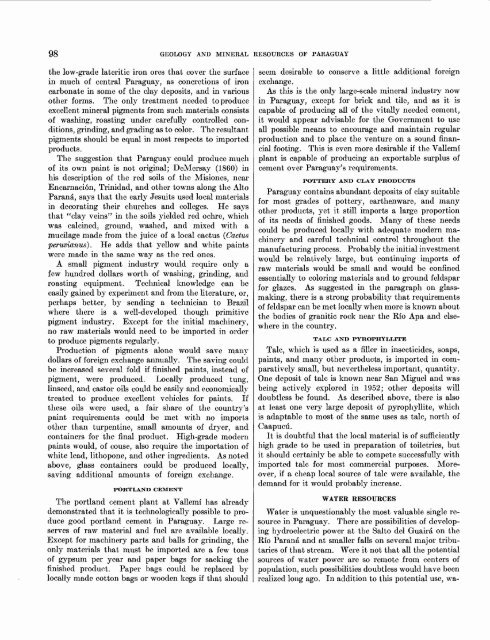Geology and Mineral Resources of Paraguay A Reconnaissance
Geology and Mineral Resources of Paraguay A Reconnaissance
Geology and Mineral Resources of Paraguay A Reconnaissance
- No tags were found...
Create successful ePaper yourself
Turn your PDF publications into a flip-book with our unique Google optimized e-Paper software.
98 GEOLOGY AND MINERAL RESOURCES OF PARAGUAYthe low-grade lateritic iron ores that cover the surfacein much <strong>of</strong> central <strong>Paraguay</strong>, as concretions <strong>of</strong> ironcarbonate in some <strong>of</strong> the clay deposits, <strong>and</strong> in variousother forms. The only treatment needed to produceexcellent mineral pigments from such materials consists<strong>of</strong> washing, roasting under carefully controlled conditions,grinding, <strong>and</strong> grading as to color. The resultantpigments should be equal in most respects to importedproducts.The suggestion that <strong>Paraguay</strong> could produce much<strong>of</strong> its own paint is not original; DeMersay (1860) inhis description <strong>of</strong> the red soils <strong>of</strong> the Misiones, nearEncarnacion, Trinidad, <strong>and</strong> other towns along the AltoParana*, says that the early Jesuits used local materialsin decorating their churches <strong>and</strong> colleges. He saysthat "clay veins" in the soils yielded red ochre, whichwas calcined, ground, washed, <strong>and</strong> mixed with amucilage made from the juice <strong>of</strong> a local cactus (Cactusperumanus). He adds that yellow <strong>and</strong> white paintswere made in the same way as the red ones.A small pigment industry would require only afew hundred dollars worth <strong>of</strong> washing, grinding, <strong>and</strong>roasting equipment. Technical knowledge can beeasily gained by experiment <strong>and</strong> from the literature, or,perhaps better, by sending a technician to Brazilwhere there is a well-developed though primitivepigment industry. Except for the initial machinery,no raw materials would need to be imported in orderto produce pigments regularly.Production <strong>of</strong> pigments alone would save manydollars <strong>of</strong> foreign exchange annually. The saving couldbe increased several fold if finished paints, instead <strong>of</strong>pigment, were produced. Locally produced tung,linseed, <strong>and</strong> castor oils could be easily <strong>and</strong> economicallytreated to produce excellent vehicles for paints. Ifthese oils were used, a fair share <strong>of</strong> the country'spaint requirements could be met with no importsother than turpentine, small amounts <strong>of</strong> dryer, <strong>and</strong>containers for the final product. High-grade modernpaints would, <strong>of</strong> couse, also require the importation <strong>of</strong>white lead, lithopone, <strong>and</strong> other ingredients. As notedabove, glass containers could be produced locally,saving additional amounts <strong>of</strong> foreign exchange.PORTLAND CEMENTThe portl<strong>and</strong> cement plant at Vallemi has alreadydemonstrated that it is technologically possible to producegood portl<strong>and</strong> cement in <strong>Paraguay</strong>. Large reserves<strong>of</strong> raw material <strong>and</strong> fuel are available locally.Except for machinery parts <strong>and</strong> balls for grinding, theonly materials that must be imported are a few tons<strong>of</strong> gypsum per year <strong>and</strong> paper bags for sacking thefinished product. Paper bags could be replaced bylocally made cotton bags or wooden kegs if that shouldseem desirable to conserve a little additional foreignexchange.As this is the only large-scale mineral industry nowin <strong>Paraguay</strong>, except for brick <strong>and</strong> tile, <strong>and</strong> as it iscapable <strong>of</strong> producing all <strong>of</strong> the vitally needed cement,it would appear advisable for the Government to useall possible means to encourage <strong>and</strong> maintain regularproduction <strong>and</strong> to place the venture on a sound financialfooting. This is even more desirable if the Vallemiplant is capable <strong>of</strong> producing an exportable surplus <strong>of</strong>cement over <strong>Paraguay</strong>'s requirements.POTTERY AND CLAY PRODUCTS<strong>Paraguay</strong> contains abundant deposits <strong>of</strong> clay suitablefor most grades <strong>of</strong> pottery, earthenware, <strong>and</strong> manyother products, yet it still imports a large proportion<strong>of</strong> its needs <strong>of</strong> finished goods. Many <strong>of</strong> these needscould be produced locally with adequate modern machinery<strong>and</strong> careful technical control throughout themanufacturing process. Probably the initial investmentwould be relatively large, but continuing imports <strong>of</strong>raw materials would be small <strong>and</strong> would be confinedessentially to coloring materials <strong>and</strong> to ground feldsparfor glazes. As suggested in the paragraph on glassmaking,there is a strong probability that requirements<strong>of</strong> feldspar can be met locally when more is known aboutthe bodies <strong>of</strong> granitic rock near the Rio Apa <strong>and</strong> elsewherein the country.TALC AND PYROPHYLLITETalc, which is used as a filler in insecticides, soaps,paints, <strong>and</strong> many other products, is imported in comparativelysmall, but nevertheless important, quantity.One deposit <strong>of</strong> talc is known near San Miguel <strong>and</strong> wasbeing actively explored in 1952; other deposits willdoubtless be found. As described above, there is alsoat least one very large deposit <strong>of</strong> pyrophyllite, whichis adaptable to most <strong>of</strong> the same uses as talc, north <strong>of</strong>Caapucu.It is doubtful that the local material is <strong>of</strong> sufficientlyhigh grade to be used in preparation <strong>of</strong> toiletries, butit should certainly be able to compete successfully withimported talc for most commercial purposes. Moreover,if a cheap local source <strong>of</strong> talc were available, thedem<strong>and</strong> for it would probably increase.WATER RESOURCESWater is unquestionably the most valuable single resourcein <strong>Paraguay</strong>. There are possibilities <strong>of</strong> developinghydroelectric power at the Sal to del Guaira on theRio Parana <strong>and</strong> at smaller falls on several major tributaries<strong>of</strong> that stream. Were it not that all the potentialsources <strong>of</strong> water power are so remote from centers <strong>of</strong>population, such possibilities doubtless would have beenrealized long ago. In addition to this potential use, wa-
















